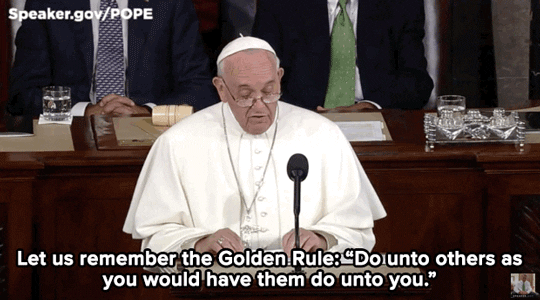September 14, 2021
either/view ⚖️
Hindus, Hinduism & Hindutva
To: either/view subscribers
Good morning. We all wish to live long. What if there is a way to crack the secret mantra for it?
Jeff Bezos, the founder and former CEO of Amazon, is investing money in researching and finding a way to live longer. He is backing Altos Labs, a company that is pursuing biological reprogramming technology to rejuvenate cells. This could prolong life!

📰 FEATURE STORY
‘Dismantling Global Hindutva’ Conference – Dismantling Hindutva or Veiled Hinduphobia?

The battle between Hindutva and anti-Hindutva forces is never-ending. It has now got a foreign makeover and the conference titled ‘Dismantling Global Hindutva’ has been the recent catalyst. This academic conference was aimed at discussing and debating issues around Hindutva. Several institutions and sponsors came together to support the conference. However, Hindu groups and activists opposed this, claiming that it paints a false picture of Hindus.
Context
The pro and anti-Hindutva people have shifted their modes of debate to organising conferences and publishing articles. In a similar fashion, the ‘Dismantling Global Hindutva’ conference was organised. It took place between September 10-12.
The conference was co-sponsored by around 70 academic units from 49 universities. The conference featured different speakers who were renowned academicians, journalists and leading activists. According to its official website, the event covered several topics like ‘what is global Hindutva’, ‘white supremacy’, ‘Hinduism and Hindutva’ and ‘caste and Hindutva’.
The conference was aimed at ‘exploring the consolidation of Hindu supremacist ideology in India and elsewhere’. It received support from more than 40 North American universities including Harvard and Stanford. But critics called it an attack on Hindus and demanded the event be cancelled.
Before we understand the debate, what is the difference between Hinduism and Hindutva? While the former is the name given to the most ancient religion, the latter is identified as a right-wing political movement.
The Conference is against Hinduism
The conference took place amidst strong opposition. While that is an altogether different story, here’s why Hindu activists were against the conference. Basically, they believe that this conference is an attack against Hinduism and not just Hindutva. It is used to corrupt the understanding of the Hindu community and establish Hindutva as a threat.
The groups touted it as ‘Hindu phobic’. They feared that the event could spark hatred against Hinduism. The statement released by the Coalition of Hindus in North America read that the event creates a false image of Hindus as ‘purveyors of extremism’.
While the organisers repeatedly stressed that this event was only against a political ideology, the Hindu groups thought otherwise. Giving the groups more reason to believe so, Meena Dhanda, a panellist on the first day of the conference said, for her, there is no difference between Hindutva and Hinduism. Additionally, the panellists are said to have made Hinduphobic comments in the past.
To strengthen their stance, critics questioned why the dates of the event lay close to the anniversary of the 9/11 terror attack in the United States. An article in Opindia claims that, in hindsight, it looks like the dates were carefully chosen and was a part of the strategy to tarnish the image of Hinduism in the West. The question repeatedly posed by the critics is why the identity of the organisers remains hidden.
Experts emphasised that the event is ‘Hindu-hatred masquerading as intellectual activism’. Makarand R Paranjape, Professor of English at JNU, pointed out the flaw in the poster. In the poster, a hammer was shown uprooting a nail that resembled an RSS worker. He asked if this wasn’t an open and undisguised call to hatred and violence.
Many groups wrote to institutions and departments asking them not to support the conference institutionally. In explanation, they asserted that the event hosted was not an academic conference, but a partisan event related to politics in India. Receiving such letters, few universities withdrew their institutional support to the conference.
The Conference brings awareness about Hindutva
While few universities withdrew support, the event went on to garner sponsorship from other organizations and groups. The main stand of the supporters was that the focus of the conference was Hindutva and not Hinduism. The organisers said that the attacks and threats were full of lies and wild conspiracy theories. They said it made the critiquing of a supremacist ideology look like an attack on the Hindu faith.
Experts mentioned that the event was long overdue and necessary. Answering the criticisms, Gyanendra Pandey, Professor of History at Emory University, said that the confusion created between the usage of the terms – Hindutva and Hinduism – is deliberate. This way, the Hindu right easily gets away with criticism. He assured that Hindutva is the polar opposite of Hinduism and requires careful study and analysis, which is what the conference aimed to do.
Academicians raised concerns over the threats and oppositions against the conference. The reason is two-fold. Such actions are against free speech and are an attack on academic freedom. They are worried that this creates a negative classroom atmosphere where faculties and students will fear being trolled and harassed for any discussion on these topics.
John L Esposito, professor of religion and international affairs at Georgetown University, expressed similar concerns and called on the US academia to initiate more such discussions on Hindutva.
The speakers and their families received death and rape threats from the critics of the conference. This is one of the main reasons why the organisers continue to keep their identities private. Experts also argue that there is a lack of awareness about the ideology. They say that any criticism against Hindutva is being framed as anti-Hindu sentiment or Hinduphobia. This greatly benefits the Hindu Right groups in the US and across the world. Such framing, on the other hand, confuses organisations. So, supporters opine that clearing the air of uncertainty about the ideology is necessary.
🕵️ BEYOND ECHO CHAMBERS
For the Right:
Rupani’s Departure is an Advertisement for the Bogus Nature of the Gujarat Model
For the Left:
8 of 20 CMs picked by Modi-Shah had to vacate seat. But it’s not a bad strategy
🏴 STATE OF THE STATES
Education to refugees (Mizoram) – The refugee status is often looked upon with a frown. But the Mizoram government has welcomed refugees from Myanmar with open arms since March. Data shows that nearly 11,000 Myanmarese refugees have taken shelter in Mizoram till now. In this situation, the Mizoram government felt the need to help the refugee children on humanitarian grounds. So they have admitted 400 refugees aged between 6 and 14 to schools. Commendably, the state government has started providing them education even though they have not been granted refugee status till now. The state education minister Lalchhandama Ralte says that the right to education does not look at the nationality of a child. All children deserve education.

Courteous judge (Chhattisgarh) – Incidents that happen within the courtrooms have been receiving a lot of attention of late. But this judge’s action outside the court has caught our attention. While hearing an accident compensation case, Korba’s district and sessions court judge BP Verma came to know that the victim, who was paralysed, was waiting outside the court complex. Feeling empathetic, he walked to the parking area where the victim was waiting and delivered his judgement right there. The judge has ordered the insurance company to grant ₹20 lakh to the victim. We are awed by the judge’s display of justice.
Gifting education (Andhra Pradesh) – In the present technology-driven era, laptops have become an essential part of our lives. Recognizing this, the Andhra Pradesh government has decided to distribute free laptops to students of Classes IX – XII in the upcoming academic year 2021-22. The scheme will replace the cash dole out of ₹14,000 to mothers, under the Amma Vodi scheme. The state government has promised to hand out more than 5 lakh laptops this year.
Waiting for water (Maharashtra) – There’s no doubt that water is the elixir of life. We all need water and in equal measure. If there’s an unbalanced distribution of water, nobody will be happy. So in 2019, the Pimpri-Chinchwad administration decided to supply water only on alternate days. They said this would ensure equitable distribution to all parts of the city. Two years down the line and after multiple protests, the administration has assured to supply water every day. The Pavana dam, which is like the lifeline of the city, is full and can now provide water to everyone. We can’t stop counting days, as the daily water supply begins from November.
Reason to rejoice (Haryana) – People in Faridabad are overjoyed at the arrival of one-stop supermarket chain DMart. With a solid 94,000 sq ft. store, DMart forays into Haryana for the first time. The company which is known for its good products at affordable rates will make shopping easier at the newly developed Faridabad Neharpar. Personal care, food, home appliances and more, all under one roof is waiting for you at the DMart store.
🔢 KEY NUMBER
10,000 – Ola Futurefactory is all set to become the ‘largest all-women factory in the world’ with over 10,000 women employees, once the production runs at full scale. CEO Bhavish Aggarwal says this female-only manufacturing plant is a part of Ola’s inclusive workforce initiatives.

